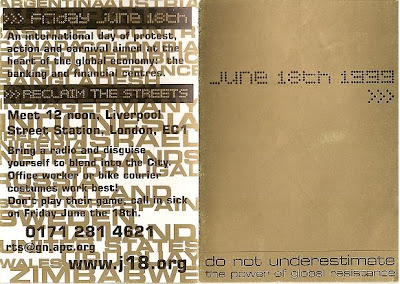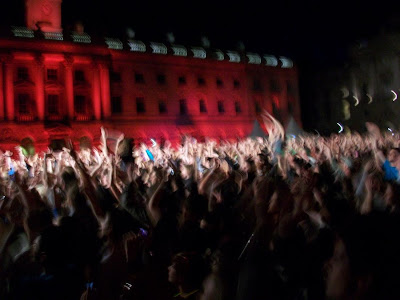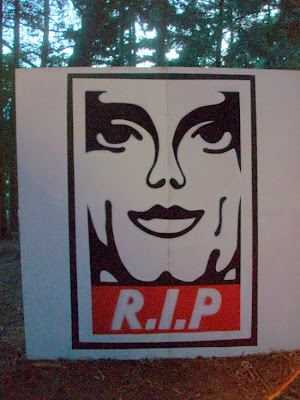Ten years ago today, the G8 Summit in Cologne was the occasion for the global
J18 'Carnival Against Capital' with demonstrations, street parties, riots and every conceivable kind of protest in places across the world.
In London I took part in the huge
carnivalesque protest initiated by
Reclaim the Streets, which saw 10,000 people converge on the financial centre of the City of London. The day started for me with a protest by the Association of Autonomous Astronauts against the militarisation of space at the London HQ of the Lockheed Martin Corporation in Berkeley Square. Police prevented several people in spacesuits from entering the building (an incident broadcast live via mobile phone on BBC Radio Scotland), but a line of people stood outside with placards saying "Stop Star Wars - Military Out of Space" and handed out leaflets, the text of which is reproduced below. As well as a contribution to the J18 it marked the start of the
AAA's 'Space 1999 - Ten Days that Shook the Universe' festival in London.
The we headed into the City where the main event was in full swing - in fact we'd already missed the famous storming of the London International Financial Futures and & Options Exchange. It was a blazing hot day and there was a sense of creative chaos with different stuff going off in all directions - one minute you were with thousands of people dancing in the streets, then you looked down an alleyway and there were people fighting with riot police. The latter seemed completely overwhelmed, I don't think anyone - authorities or activists - knew what to expect. At some point the crowd began to disperse, not in ones or twos, but in processions heading off in different directions. I remember a load of us slowly heading through an underpass with a huge sound system on a lorry shaking the walls with techno.
It was the peak of the Reclaim the Streets idea - in many different countries protests were accompanied by electronic beats from mobile sound systems. In London the police became wise to the tactic, and some of the activists also began to agonise about whether partying was getting in the way of politics (always a bad sign in the development of movements).
Stefan Szczelkun's film really captures the atmosphere, including some of the different musics on the day - drumming, samba, and at one point people dancing to
Leftfield's Open Up (with John Lydon singing 'Burn Hollywood Burn'):
The image below is from a Reclaim the Streets
flyer given out in the lead up to J18. The central quote 'To work for delight...' comes from Raoul
Vaneigem's The Revolution of Everyday Life (click image to enlarge):

 The full text of the leaflet read:
The full text of the leaflet read:
On June 18
th the leaders of the eight most powerful nations will meet for the G8 summit in Cologne, Germany. Their agenda will be the intensification of economic growth, "free" trade and more power for corporations as the only way towards a bright future. But these 'leaders' are not in control... Our planet is actually run by the financial market - a giant video game in which people buy and sell blips on electronic screens, trading life for money in their search for ever-higher profits. Yet the consequences of this frenzied game are very real: human lives, ecosystems, jobs and even entire economies are at the mercy of this reckless global system.
As the economy becomes increasingly global and interdependent those resisting its devastating social and ecological consequences are joining forces. Around the world, the movement grows - from Mexico's
Zapatistas, to France's unemployed, to India's small farmers, to those fighting road building in the UK, to anti-oil activists in Nigeria - people are taking direct action and reclaiming their lives from the insane game of the markets. Resistance will converge on June 18
th as hundreds of groups simultaneously occupy and transform banking and financial centres across the globe.
If you act like there is no possibility of change for the better, you guarantee that there will be no change for the better. The choice is ours.
Carn'ival n. 1. An explosion of freedom involving laughter, mockery, dancing, masquerade and revelry. 2. Occupation of the streets in which the symbols and ideals of authority are subverted. 3. When the marginalised take over the centre and create a world turned upside down. 4. You cannot watch carnival, you take part. 5. An unexpected carnival is revolutionary.
'To work for delight and authentic festivity is barely distinguishable from preparing for a general insurrection'
Cap'italism n. 1. A system by which the few profit from the exploitation of the many. 2. A mindset addicted to profit, work and debt which values money more than life. 3. An unsustainable ideology obsessed by growth despite our finite planet. 4. The cause of the global, social and ecological crisis. 5. A social system overthrown at the end of the 20
th century...
A massive carnival in the world's biggest financial centre - the city of London - will be Reclaim The Streets' part of the day. Let's replace the roar of profit and plunder with the sounds and rhythms of party, carnival and pleasure!
Friday June 18
th - An international day of protest, action and carnival aimed at the heart of the global economy: the banking and financial centres.
Reclaim The Streets. Meet 12 noon, Liverpool Street Station, London EC1. Bring a radio and disguise yourself to blend into the City. Office worker or bike courier costumes work best!
Don't play their game, call in sick on Friday June the 18
th
Do not underestimate the power of global resistance
Text of the AAA leaflet given out on J18:
Stop Star Wars: Military out of Space - Association of Autonomous Astronauts
While film fans wait for the new Star Wars movie the real thing is already taking shape above our heads. Space technology is a key part of the military machine being used to destroy people and buildings in Yugoslavia and Iraq. And the US and other governments are actively planning to deploy new weapons in space capable of wreaking even more destruction on planet earth. Today the Association of Autonomous Astronauts are demanding that one of the key players in the space arms race - the Lockheed Martin corporation - hands over its resources to us for the development of peaceful, galaxy-friendly community based space exploration.
From the Blitz to the Moon
Space and military technology have always gone hand in hand. In the Second World War, thousands of people were killed in London and other cities by the Nazis' V2 rocket. When the war finished, Werner Von
Braun and the other scientists responsible for the V2 were given new jobs by the US government. The V2 technology was refined and served as the basis for both
intercontinentaI Ballistic Missiles (nuclear weapons) and the Apollo Space programme that sent people to the moon.
Satellites of death
A high proportion of the satellites launched into space serve military purposes. The 1991 Gulf War saw the US combine data from surveillance, meteorological and communications satellites to deploy its war machine with lethal effectiveness. It's been the same story in the current war on Yugoslavia. For instance, B-1B Lancer bombers have been used "equipped with advanced cluster bomb units which use satellite navigation to detect and destroy targets (Guardian 3.4.99). Naturally this super-accurate space age technology hasn't stopped people being blown to bits in hospitals, houses, old people's homes, prisons and on bridges.
Star Wars - the sequel
Military satellites are only the start. The US Space Command (part of the US Air Force) is actively planning the deployment of weapons in space. According to General Joseph Ashy, commander in chief of the US Space Command (motto 'Master of Space'), "we will engage terrestrial targets someday from space. We will engage targets in space, from space" . In the 1980s Ronald Reagan's Star Wars programme was derided as a Cold War fantasy. Now the plan to deploy weapons in space to 'defend' the US from missile attack is back on with the Ballistic Missile Defence programme. These 'defensive' weapons could be quickly adapted to attack enemy satellites or targets on the ground.
Cassini - nukes in space
The use of lasers and similar weapons in space would only be feasible with powerful energy sources, and public opinion is already being softened up for nuclear powered weapons systems in space. In 1997 NASA launched the
Cassini space probe to Saturn with 32.8 kg of radioactive plutonium on board. Fortunately this rocket did not blow up on take-off (unlike many recent launches), but
Cassini is due to pass close to earth again in August 1999 with potentially catastrophic results if anything goes wrong.
Lockheed Martin
Today military and space technology are concentrated in the hands of the same big corporations. With Lockheed Martin, the two areas are even co-ordinated in the same section of the company - Lockheed Martin Missiles and Space, based in Sunnyvale, California. Lockheed have reaped millions of pounds from the US space programme as a key contractor for NASA. Today,
LM Missiles and Space are involved in the space shuttle programme and the development of the International Space Station. At the same time they are continuing to develop Trident missiles, nuclear weapons currently deployed by the US and UK governments in nuclear powered submarines in oceans across the world. Lockheed Martin UK is a major defence contractor for the Ministry of Defence, completing the installation of Tomahawk Land Attack Missiles on Royal Navy submarines just in time for their use in Yugoslavia.
AAA
The Association of Autonomous Astronauts is opposed to the commercial and military exploitation of space. We really don't think it's worth going through all the effort of getting into space just to live by the same rules as on earth. What attracts us to space exploration is the possibility of doing things differently. We are not interested in finding out what's its like to work in space, to find new ways of killing. We want to find out what dancing or sex feels like in zero gravity, to find new ways of living.
As part of the J18 global festival against corporate exploitation we demand that Lockheed Martin decommissions its weapon-making capability and hands over its resources to the AAA. We will be outlining our programme of community-based, galaxy-friendly space exploration in our Space 1999 festival, which starts today.
There is some footage of the AAA J18 protest in this AAA video.
Other relections: Christoph Fringeli at Datacide - 10 Years J18 199; Ian Bone.
 It was all hands in the air at Somerset House last week (20 July) for Calvin Harris, inciting a Monday night outdoor crowd to jump around: 'London.... are you ready to go off?'.
It was all hands in the air at Somerset House last week (20 July) for Calvin Harris, inciting a Monday night outdoor crowd to jump around: 'London.... are you ready to go off?'. I know Calvin Harris is everywhere with his electro-dance-pop, but what's not to like? He played Acceptable in the 80s, I Created Disco (complete with its fake sample suggesting that disco was created in some post-WW2 laboratory experiment) and new melancholic/euphoric anthem I'm not Alone. No Dance Wiv Me unfortunately in the absence of Dizzee Rascal.
I know Calvin Harris is everywhere with his electro-dance-pop, but what's not to like? He played Acceptable in the 80s, I Created Disco (complete with its fake sample suggesting that disco was created in some post-WW2 laboratory experiment) and new melancholic/euphoric anthem I'm not Alone. No Dance Wiv Me unfortunately in the absence of Dizzee Rascal.






 Something that has been around for while is
Something that has been around for while is 











